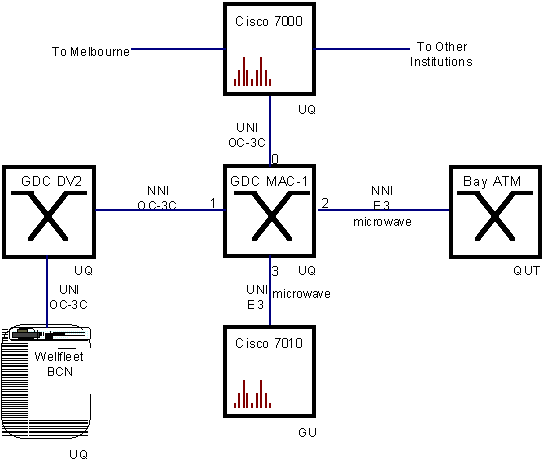
Jonathan Cheng and Mark Williams
Prentice Centre
The University of Queensland
Brisbane Qld 4072
{J.Cheng, M.Williams}@cc.uq.edu.au
This paper updates a paper [1] presented by the same authors at QUESTNET '95 in September, 1995. It describes ATM network installation activities at The University of Queensland and between Southeast Queensland Universities between September 1995 and July 1996 and outlines some plans for the future.
This paper is an update of a paper published by the same authors [1] about 10 months ago in September, 1995. That paper described the installation to that stage of a wide-area ATM network comprising of 3 switches and 5 routers across The University of Queensland, The Queensland University of Technology and Griffith University. Figures 1 and 2 show the network configuration as at late 1995.

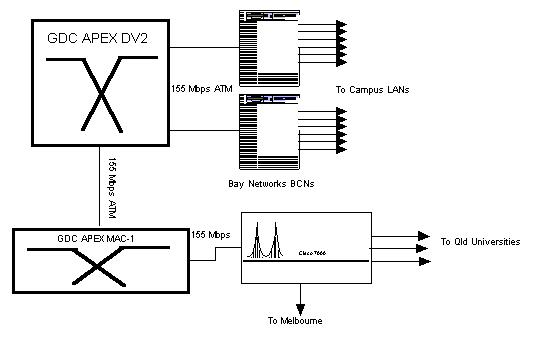
This section covers some old ground that is mostly covered in [1]. Those readers who are familiar with our previous paper can skip section 2 if they wish.
Before continuing with the description of how ATM technology has been introduced at UQ and in the south-east Queensland region of QUESTNET, it is worthwhile to recapitulate the reasons why ATM transmission has been introduced.
ATM transmission is certainly not the only technology that can satisfy any of the criteria above. ATM is, however, the only technology currently available that satisfies all three.
All ATM switches are not alike. Even though all ATM switches perform cell relay, switches differ markedly in such aspects as the variety of interfaces and services supported, redundancy, the presence of ATM internetworking software and the sophistication of traffic management mechanisms. ATM switching systems can be segmented into four distinct types:
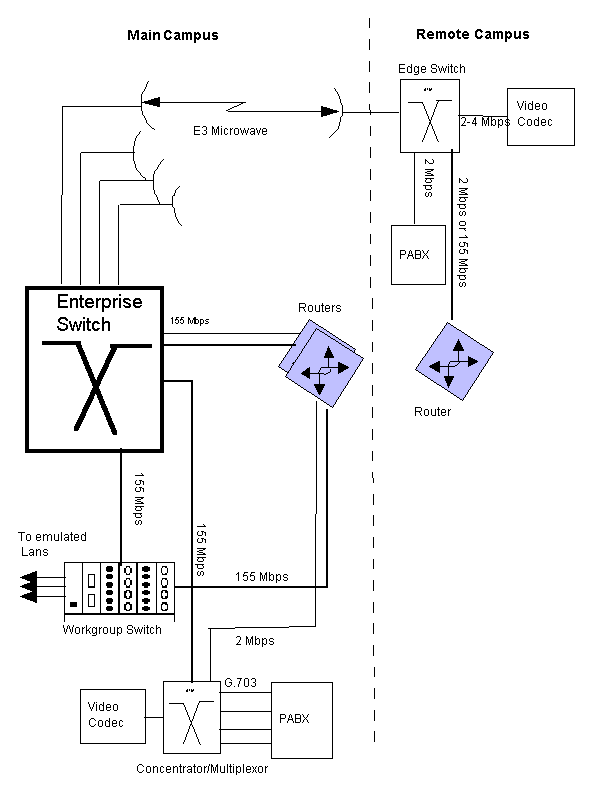
Enterprise ATM switches are sophisticated multi-service devices designed to form the core backbones of enterprise networks, complementing the role played by high-end multiprotocol routers today. Enterprise switches will be used, to interconnect workgroup ATM switches ATM edge switches, ATM concentrators and other ATM-connected devices such as LAN switches. Enterprise-class switches, however, can act not only as ATM backbones, but can serve as the single point of integration for all of the disparate services and technology found in enterprise backbones today. By integrating all of these services onto a common platform and a common ATM transport infrastructure, network designers can gain greater manageability while eliminating the need for multiple overlay networks.
Features to be expected in Enterprise ATM Switches are:
Workgroup ATM switches are optimised for deploying ATM to the desktop over low-cost ATM desktop interfaces, with ATM signaling interoperability with ATM adapters and QoS support for multimedia applications.
The typical workgroup switch will have most of the following features:
The typical application for an edge switch in a University would be to be the switch that terminates a wide-area link at a smaller campus. An edge switch has many of the features of an enterprise switch but will omit some of the more expensive features aimed at providing high availability. Because it may be the only switch present on the smaller campus, it may also support some workgroup switch features.
Campus ATM switches will generally be used for small-scale ATM backbones - for instance, to link ATM routers or LAN switches - thus alleviating current backbone congestion and enabling deployment of such new services as VLANs. Campus switches will need to support a wide variety of both local backbone and wide-area interface types, but will be price/performance optimized for the local backbone function. Also important in this class of switches are ATM routing capabilities to allow multiple switches to be tied together and congestion control mechanisms for optimizing backbone performance.
The concentrator/multiplexer is a device for providing circuit-emulation or other adaptation services across an ATM network infrastructure. One of these devices might typically have a single 155 Mbps or 34 Mbps ATM cell interface and a number of 2 Mbps CBR or frame-based VBR interfaces. A concentrator/multiplexer does not need to be very sophisticated in terms of signalling (in fact it need not support signalling at all) or traffic management or have a very high-capacity switching fabric, so it can be relatively inexpensive.
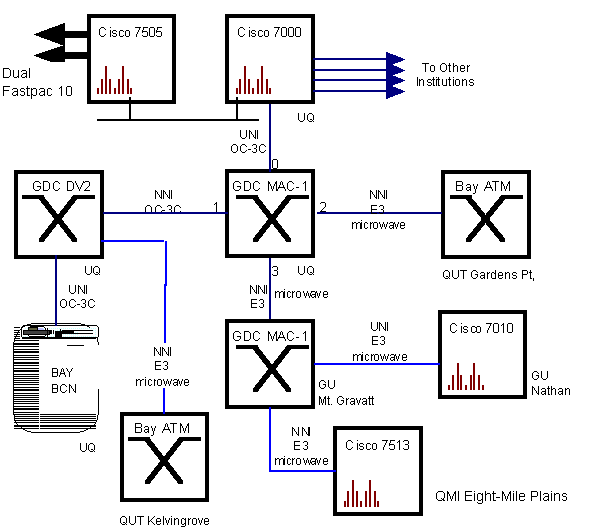
Most of the completed development since October, 1995 has been outside the University of Queensland. The two most important projects have been the integration of the link between QUT Gardens Pt. And QUT Kelvingrove into the QUESTNET ATM network and the addition of a link to the Queensland Manufacturing Institute (QMI) at Eight-Mile Plains.
QUT has installed an E3 microwave link between its Kelvin Grove campus and UQ St. Lucia campus to connect its Kelvin Grove campus and Gardens Point campus through UQ St. Lucia campus, as there is no line of sight between Kelvin Grove campus & Gardens Point campus and there is an existing link between Gardens Point campus & UQ St. Lucia Campus.
The Kelvin Grove end of the new microwave link will be connected to a new Bay Networks ATM switch and the St. Lucia end will be connected to UQ's GDC DV2. The new Bay ATM switch in Kelvin Grove will be connected to the Bay 11014 ATM switch in Gardens Point via the UQ GDC DV2 and the QUESTNET GDC MAC-1 in St. Lucia. A Permanent Virtual Path (PVP) will be set up between the two GDC ATM switches for the traffic streams between the two QUT campuses. QUT can set up PVCs for traffic streams between the two campuses, all with the same VPI as the one specified in the PVP This will allow QUT staff to manage connections between their campuses without the need for reconfguration of intermediate switches..
An additional QUESTNET Point of Presence (PoP) has been established at GU Mt. Gravatt campus and a new GDC MAC-1 has been installed for this purpose. The Queensland Manufacturing Institute (QMI) in Eight Mile Plains was connected to QUESTNET via an E3 microwave system connected to the PoP in GU Mt. Gravatt in May 1996.
The University of Queensland houses a High-Performance Computing Unit (HPCU). The HPCU operates a 6.6 GFLOP Silicon Graphics (SGI) Power Challenge system, an Onyx Reality Engine, and a network of about 30 Indigo, Indy ZX, and Indy workstations. Since these workstations are used mostly for visualization, they will eventually require high-capacity connections to the Power Challenge systems and Onyx Reality Engine.
A sum of $80,000 was allocated for the purchase of ATM workgroup switching equipment in 1995. In August 1995, the University issued a Request For Tender (RFT) from vendors interested in supplying ATM Workgroup Switching Equipment to connect the SGI high-performance computing engines and visualization stations via ATM. In a workgroup switch, large numbers of low-cost MMF and UTP ATM UNI connections will be available. The workgroup switch specification mandated the support of the ATM Forum UNI Version 3.0 or 3.1 signaling for SVC and ATM Forum LAN Emulation (LANE) Version 1.0. Support of Classical IP over ATM (RFC 1577) and/or RFC 1483 were to be preferred. Where extra elements were required to provide full LANE support, there were to be included in the tendered price.
There were responses from four vendors which would have allowed UQ to purchase ATM workgroup switching equipment within the budget allowed. The Bay Networks Centillion 100 proposal was selected.
A Bay Networks Centillion 100 ATM switch with 8 OC-3c MMF ATM UNI/NNI ports was ordered in January 1996. Major features of the specifications of the Centillion 100 are listed below:
Furthermore, an upgrade of the OC-3c MMF ATM interface in the Prentice Bay BCN router to the ATM Routing Engine (ARE) & associated ARE link module was also ordered for LANE support. Major features of the ARE are listed below:
The initial implementation diagram is shown in Figure 5.
Given the vast installed base of LANs and WANs today and the network and link layer protocols operating on these networks, a key to ATM success will be the ability to allow for interoperability between these technologies and ATM. Few users will tolerate the presence of islands of ATM without connectivity to the remainder of the enterprise network. The key to such connectivity is the use of the same network layer protocols, such as IP and IPX, on both existing networks and on ATM, since it is the function of the network layer to provide a uniform network view to higher level protocols and application. LANE protocols define a service interface for higher layer (i.e. network layer) protocols, which is identical to existing LANs, and that data sent across the ATM network are encapsulated in the appropriate LAN MAC packet format. This makes an ATM network look and behave like an Ethernet or Token Ring LAN, except that it operates much faster than a real such network.
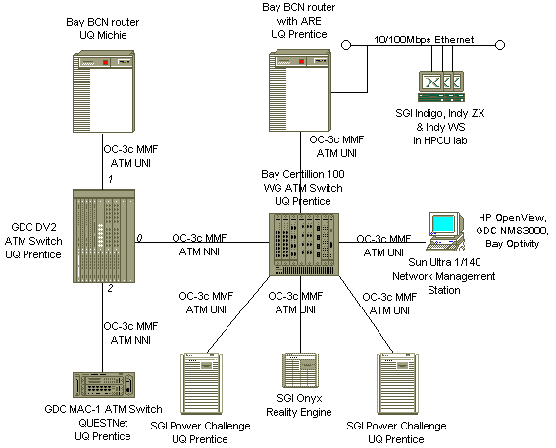
The ATM Routing Engine enables the BCN router to become a Virtual Network Router (VNR). The Centillion 100, the BCN, the ATM-attached SGI systems together with their LANE V1.0 software interact to form a emulated LAN environment as shown in Figure 6.
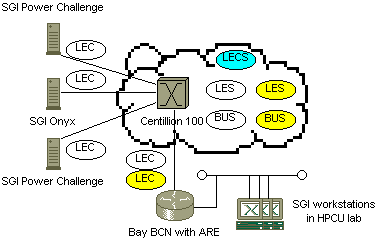
Some of the other comparable workgroup ATM switches available (or soon to be available) in the market are listed below:
A sum of $500,000 was allocated to upgrade the campus network in Gatton campus and its connection to the St. Lucia campus in January 1996. A new ATM-based E3 microwave link is being installed between St. Lucia and Gatton campuses. Data, PABX voice traffic and video-conferencing traffic between the two campuses will be transported on the new ATM-based E3 microwave link. Full-motion video will also be transported on the E3 link in the future.
A Cisco LS2020 ATM switch with two SONET/SDH OC-3c MMF ATM UNI/NNI port and eight E1 G.703 circuit emulation adaptation ports was ordered in February for use in St. Lucia. Another LS2020 with four G.804/G.832 E3 ATM UNI/NNI ports and eight E1 G.703 circuit emulation adaptation ports was also ordered for use in Gatton. Both switches have been delivered and are under test. The microwave link is expected to be installed by early July.
Highlights of the technical characteristics of the Cisco LS2020 are listed below:
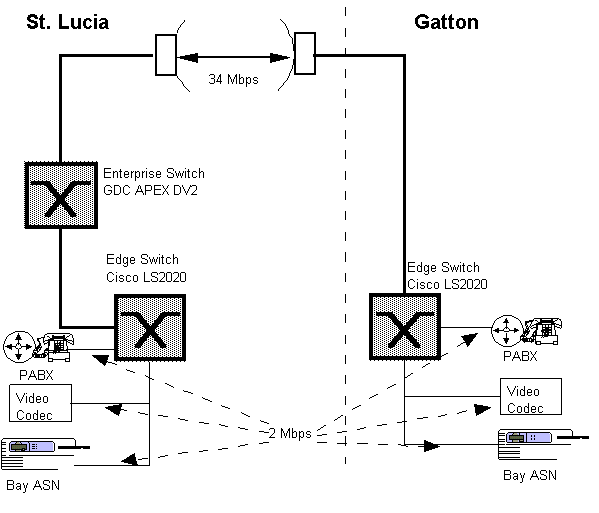
The interconnections between the routers, PABX systems and ATM switches in the two campuses are shown in Figure 7. The PABX voice stream, data streams and early video transmission will all use the ATM CBR service which uses AAL1. In the LS2020 in St. Lucia, the voice and data streams for Gatton will be multiplexed onto the OC-3c MMF NNI port, passed to the GDC DV2 and carried on the new microwave link to the LS2020 in Gatton, which will demultiplex the voice stream and data stream and pass them to the PABX system and Bay ASN router in Gatton correspondingly. The two LS2020 switches will communicate via a permanent virtual path and will be unaware that they are separated by a GDC switch.
It is expected that later in 1996, the University of Southern Queensland will also install an E3 microwave link between its campus in Toowoomba and UQ Gatton campus. It will then connect its campus network to the QUESTNET PoP in UQ St. Lucia campus through the LS2020 in Gatton and the two new microwave links connecting Toowoomba and St. Lucia. PVCs or SVCs will be setup in the ATM network for VBR data or CBR voice/video traffic.
By July 1996, the circuit-switched terminal network in UQ will have been phased out. The data network (UQNET) and PABX interconnection network (but not the actual voice network) will continue to be integrated into the single ATM WAN. The only other important network in UQ that has not been integrated into the ATM WAN is the CVRS fibre-optic video distribution network.
The ATM WAN will continue to grow in the future. The plan is to install more ATM-based E3 microwave links to remote campus (e.g. teaching facilities in RBH-Herston and PA-Woollongaba) to provide PABX, data, video and video-conferencing service to the remote campuses.
Integration of the CVRS network into the ATM WAN will start "soon". A large number of video codecs and Circuit Emulation interfaces in ATM switches will be needed, and to a degree we are still waiting for the technology to become cheap enough to allow 100 connections to be made at a reasonable price. Once the CVRS network has been integrated into the existing ATM WAN, UQ will have a single network (i.e. the ATM WAN) carrying traffic that was once carried over four separate networks. This will mean cost savings in the long term. Furthermore, individual links will be upgraded when bandwidth demanded is higher than the capacity (e.g. remote campus E3 microwave link may be upgraded to 155Mbps).
With regard to new ITU-T and ATM Forum ratified standards which will enhance functionality, manageability & reliability, the UQ and QUESTNET technical team will look to integrating them in the ATM WAN. Those standards will include ATM Forum UNI V4.0, P-NNI Private Network to Network Interface, MPOA Multiprotocol Over ATM.
With regard to QUESTNET, a new E3 microwave link between GU Mt. Gravatt campus and QUT Gardens Point campus may be installed if it is justified and funding becomes available. By then, the three QUESTNET PoP in the three university campuses will form a triangle, providing path redundancy and improving the reliability of QUESTNET. The three microwave links can be upgraded to 155Mbps as demand dictates and funding and pricing allow,
Griffith University's installation of a microwave ATM link between its Mt. Gravatt and Nathan campuses will allow the connection of Bond University into the QUESTNET ATM network. A link is also planned between USQ and the UQ Gatton Campus.
Figure 8 illustrates the QUESTNET ATM WAN and its connection to the ATM WANs of its member institutions.
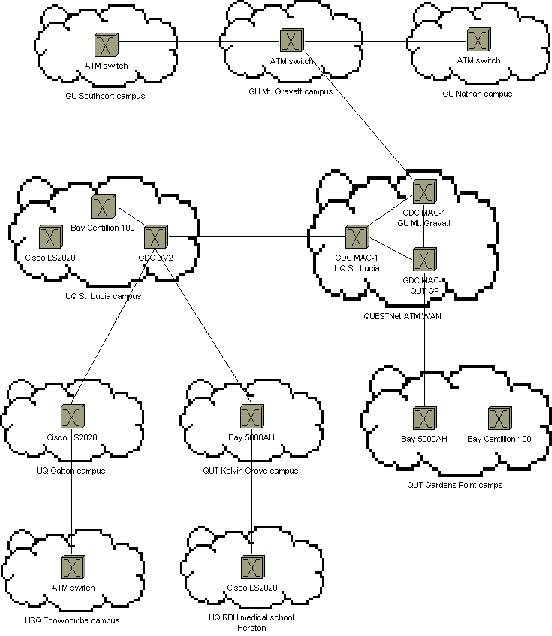
[1] Williams M.I. and Cheng, J. "Installing an ATM Network - a War Story". Presented at QUESTNET '95. Gold Coast, Australia. September, 1995.